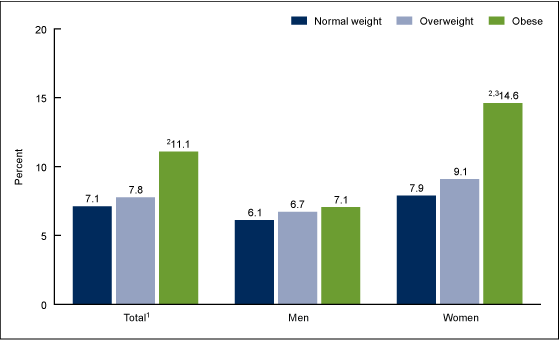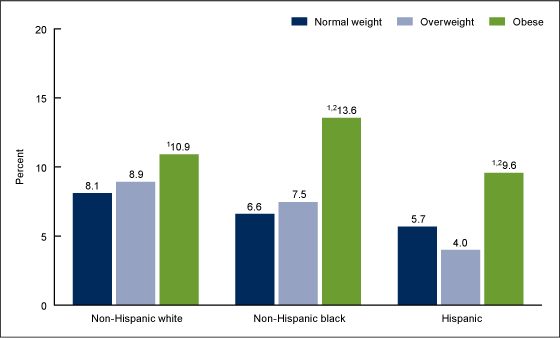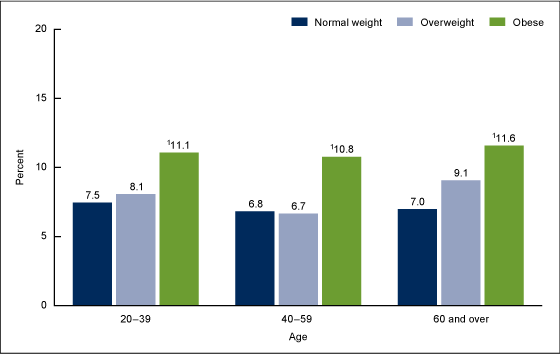Current Asthma Prevalence by Weight Status Among Adults: United States, 2001–2014
- Key findings
- Unlike men, women with obesity had higher current asthma prevalence than those in lower weight categories.
- Current asthma prevalence was higher among adults with obesity than among those with normal weight for all race and Hispanic origin groups.
- Across all adult age groups, current asthma prevalence was significantly higher among adults with obesity compared with those in lower weight categories.
- From 2001–2002 to 2013–2014, current asthma prevalence significantly increased among adults; by weight status, asthma prevalence increased among adults in the overweight category but not among adults in normal weight or obese categories.
- Summary
- Definitions
- Data sources and methods
- About the authors
- References
- Suggested citation
NCHS Data Brief No. 239, March 2016
Lara J. Akinbami, M.D., and Cheryl D. Fryar, M.S.P.H.
Key findings
Data from the National Health and Nutrition Examination Survey, 2001-2014
- In 2011–2014, current asthma prevalence was 8.8% among adults. It was higher among adults with obesity (11.1%) compared with adults in normal weight (7.1%) and overweight (7.8%) categories.
- Women with obesity had higher current asthma prevalence (14.6%) than those in normal weight (7.9%) and overweight (9.1%) categories. Current asthma prevalence did not differ significantly by weight status for men.
- Current asthma prevalence was highest among adults with obesity for all race and Hispanic origin groups and age groups.
- Overall current asthma prevalence among adults increased from 2001–2002 (7.1%) to 2013–2014 (9.2%). By weight status, prevalence increased among overweight adults but not among adults in the obese or normal weight categories.
Asthma is a common chronic airway disorder characterized by periods of airflow obstruction known as asthma attacks (1). Symptom frequency can range from intermittent to constant, and attack severity can vary from mild to life threatening (1). Several studies have shown that among adults, obesity is associated with an increased risk of asthma diagnosis, more frequent asthma-related health care use, and greater symptom or severity burden (2–6). In this report, current asthma prevalence is examined by weight status among U.S. adults aged 20 and over.
Keywords: lung disease, obesity, National Health and Nutrition Examination Survey
Unlike men, women with obesity had higher current asthma prevalence than those in lower weight categories.
- During 2011–2014, current asthma prevalence was 8.8% among adults overall. Prevalence was significantly higher among adults with obesity (11.1%) compared with adults in normal weight (7.1%) and overweight (7.8%) categories (Figure 1).
- Among men, there were no significant differences in current asthma prevalence by weight status.
- As observed overall, women with obesity had significantly higher current asthma prevalence (14.6%) compared with women in the normal weight (7.9%) and overweight (9.1%) categories.
- Among adults with obesity, women had significantly higher current asthma prevalence compared with men. For both the normal weight and overweight categories, there was no significant difference in current asthma prevalence between men and women.
Figure 1. Current asthma prevalence among adults aged 20 and over, by weight status and sex: United States, 2011–2014
1Overall current asthma prevalence among adults, including the underweight category that is not shown separately, was 8.8%.
2Significantly higher than normal weight and overweight categories (p < 0.05).
3Significantly higher than men (p < 0.05).
NOTES: Age-adjusted by the direct method to the 2000 U.S. Census population using age groups 20–39, 40–59, and 60 and over.
Access data table for Figure 1.
SOURCE: CDC/NCHS, National Health and Nutrition Examination Survey, 2011–2014.
Current asthma prevalence was higher among adults with obesity than among those with normal weight for all race and Hispanic origin groups.
- The prevalence of current asthma among non-Hispanic white adults with obesity (10.9%) was significantly higher than among those in the normal weight (8.1%) category (Figure 2).
- Among non-Hispanic black adults, the prevalence of current asthma among adults with obesity (13.6%) was significantly higher than among those in the overweight (7.5%) and normal weight (6.6%) categories.
- Similarly, Hispanic adults with obesity had higher current asthma prevalence (9.6%) than those in the overweight (4.0%) and normal weight (5.7%) categories.
- There were no significant differences in current asthma prevalence between adults in the normal weight and overweight categories within any race and Hispanic origin group.
Figure 2. Current asthma prevalence among adults aged 20 and over, by weight status and race and Hispanic origin: United States, 2011–2014
1Significantly higher than normal weight (p < 0.05).
2Significantly higher than overweight (p < 0.05).
NOTES: Age adjusted by the direct method to the 2000 U.S. Census population using age groups 20–39, 40–59, and 60 and over.
Access data table for Figure 2.
SOURCE: CDC/NCHS, National Health and Nutrition Examination Survey, 2011–2014.
Across all adult age groups, current asthma prevalence was significantly higher among adults with obesity compared with those in lower weight categories.
- For all age groups, adults with obesity had significantly higher current asthma prevalence than adults in the normal weight and overweight categories. For example, among adults aged 20–39, asthma prevalence was 11.1% among adults with obesity, 8.1% among adults in the overweight category, and 7.5% among adults in the normal weight category (Figure 3).
- Among adults aged 60 and over, there was a significant trend of increasing asthma prevalence with weight status, 7.0% among normal weight adults, 9.1% among overweight adults, and 11.6% among adults with obesity.
Figure 3. Current asthma prevalence among adults aged 20 and over, by weight status and age group: United States, 2011–2014
1Significantly higher than normal weight and overweight adults in same age group (p < 0.05).
NOTE: Access data table for Figure 3.
SOURCE: CDC/NCHS, National Health and Nutrition Examination Survey, 2011–2014.
From 2001–2002 to 2013–2014, current asthma prevalence significantly increased among adults; by weight status, asthma prevalence increased among adults in the overweight category but not among adults in normal weight or obese categories.
- Among adults, overall current asthma prevalence increased significantly from 2001–2002 (7.1%) to 2013–2014 (9.2%) (Figure 4).
- Among weight status subgroups, current asthma prevalence increased among adults in the overweight category, from 5.6% in 2001–2012 to 8.4% in 2013–2014.
- There was no significant trend in current asthma prevalence among adults in the normal weight or obese categories.
Figure 4. Current asthma prevalence among adults aged 20 and over, by weight status: United States, 2001–2014
1Significantly increasing trend (p < 0.05).
NOTES: Age-adjusted by the direct method to the 2000 U.S. Census population using the age groups 20–39, 40–59, and 60 and over.
Access data table for Figure 4.
SOURCE: CDC/NCHS, National Health and Nutrition Examination Survey, 2001–2014.
Summary
In 2011–2014, current asthma prevalence was higher among adults with obesity compared with adults in lower weight categories. This pattern was consistent across most demographic subgroups, except among men, for whom no statistically significant difference in current asthma prevalence by weight status was observed. Other epidemiologic studies of asthma prevalence have shown conflicting results about whether obesity is a risk factor for asthma among males (2,4). By race and Hispanic origin, current asthma prevalence was highest among adults with obesity for all groups. Patterns differed slightly among groups. For non-Hispanic black and Hispanic adults, prevalence for those with obesity was higher than for those in the normal weight and overweight categories. For non-Hispanic white adults, there was no significant difference in asthma prevalence between the obese and overweight categories. For all age groups, current asthma prevalence was highest among adults with obesity, and there was no significant difference in asthma prevalence between those in the normal weight and overweight categories. There was an increasing trend in asthma prevalence as weight increased that was observed most clearly in the 60 and over age group. From 2001 to 2014, there was an increasing trend in current asthma prevalence among adults overall and among overweight adults. However, no significant trend was observed among adults in other weight categories.
Findings from an American Thoracic Society workshop on obesity and asthma concluded that obesity is a major risk factor for asthma, and that obesity-related asthma is likely different from other types of asthma (e.g., allergic, occupational, exercise-induced, nocturnal, aspirin-sensitive, and severe asthma) (4).
Definitions
Current asthma prevalence: Measured based on affirmative responses to the following questions: “Have you ever been told by a doctor or other health professional that you have asthma?” and “Do you still have asthma?” Data on current asthma status among adults is available in National Health and Nutrition Examination Surveys (NHANES) beginning with the 2001–2002 survey.
Weight status: Body mass index (BMI) is weight in kilograms divided by height in meters squared (kg/m2), rounded to the nearest tenth. Normal weight is a BMI of at least 18.5 kg/m2 and less than 25 kg/m2. Underweight category (less than 18.5 kg/m2) had an insufficient sample size to generate reliable estimates and was not included as a separate category but is included in estimates for the total population. Overweight is a BMI of at least 25 kg/m2 and less than 30 kg/m2. Obesity is a BMI greater than or equal to 30 kg/m2.
Data sources and methods
Data from the 2001–2002, 2003–2004, 2005–2006, 2007–2008, 2009–2010, 2011–2012, and 2013–2014 NHANES were used for these analyses. Data from NHANES 2011–2014 (4 years of data) were used to test differences between demographic subgroups, thus increasing the sample size and the power to detect a difference in prevalence (7). Survey participants were selected using a complex, multistage probability design. Participants were interviewed in their homes and then underwent standardized physical examinations in a mobile examination center. Pregnant women were excluded from these analyses.
In 2011–2012 and 2013–2014, non-Hispanic black, non-Hispanic Asian, Hispanic adults, and other groups were oversampled in order to obtain reliable estimates for these population subgroups. Race and Hispanic origin-specific estimates reflect individuals reporting only one race. Those reporting more than one race are included in the total but not reported separately.
Examination sample weights, which account for differential selection probabilities, nonresponse, and noncoverage, are used in the estimation of national estimates. Variance estimation accounted for the complex survey design. All results presented have a relative standard error of less than 30%. Differences between groups were tested using a t statistic with the appropriate degrees of freedom at the p < 0.05 significant level (where p is the probability of rejecting the null hypothesis when it is true). Linear survey trends were tested using orthogonal contrast matrices. All differences reported are statistically significant unless otherwise indicated. Statistical analyses were conducted using SAS System for Windows release 9.3 (SAS Institute Inc., Cary, N.C.) and SUDAAN release 11.0 (RTI International, Research Triangle Park, N.C.).
About the authors
Lara J. Akinbami and Cheryl D. Fryar are with CDC’s National Center for Health Statistics, Division of Health and Nutrition Examination Surveys.
References
- Expert panel report 3: Guidelines for the diagnosis and management of asthma. Bethesda, MD: National Heart, Lung, and Blood Institute, National Institutes of Health. 2007.
- Beuther DA, Sutherland ER. Overweight, obesity, and incident asthma: A meta-analysis of prospective epidemiologic studies. Am J Respir Crit Care Med 175(7):661–6. 2007.
- Sin DD, Jones RL, Man SF. Obesity is a risk factor for dyspnea but not for airflow obstruction. Arch Intern Med 162(13):1477–81. 2002.
- Dixon AE, Holguin F, Sood A, Salome CM, Pratley RE, Beuther DA, et al. An official American Thoracic Society workshop report: Obesity and asthma. Proc Am Thorac Soc 7(5):325–35. 2010.
- Peters JI, McKinney JM, Smith B, Wood P, Forkner E, Galbreath AD. Impact of obesity in asthma: Evidence from a large prospective disease management study. Ann Allergy Asthma Immunol 106(1):30–5. 2011.
- Taylor B, Mannino D, Brown C, Crocker D, Twum-Baah N, Holguin F. Body mass index and asthma severity in the National Asthma Survey. Thorax 63(1):14–20. 2008.
- Johnson CL, Dohrmann SM, Burt VL, Mohadjer LK. National Health and Nutrition Examination Survey: Sample design, 2011–2014. National Center for Health Statistics. Vital Health Stat 2(162). 2014.
Suggested citation
Akinbami LJ, Fryar CD. Asthma prevalence by weight status among adults: United States, 2001–2014. NCHS data brief, no 239. Hyattsville, MD: National Center for Health Statistics. 2016.
Copyright information
All materials appearing in this report is in the public domain and may be reproduced or copied without permission; citation as to source, however, is appreciated.
National Center for Health Statistics
Charles J. Rothwell, M.S., M.B.A., Director
Nathaniel Schenker, Ph.D., Deputy Director
Jennifer H. Madans, Ph.D., Associate Director for Science
Division of Health and Nutrition Examination Surveys
Kathryn Porter, M.D., M.S., Director
Ryne Paulose-Ram, Ph.D., Associate Director for Science



